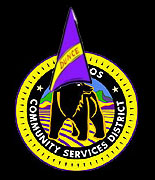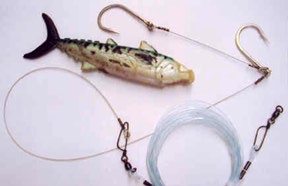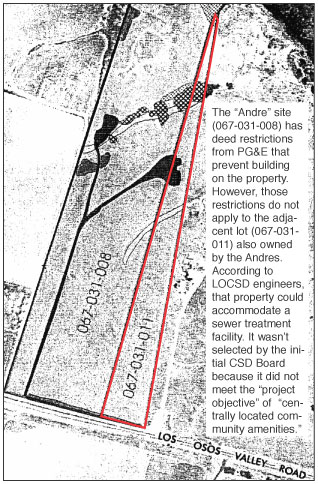(Note: I originally posted the following article on July 27, but I resposted it to bring it back to the top of SewerWatch... because I like it.)Six Years of Unimaginably Poor
Decision Making by the LOCSDby Ron Crawford
sewerwatch.blogspot.com
No matter how the sewer issue finally plays out, one thing is for sure, the Los Osos Community Services District's clumsy handling of the project over the past six years will become legend in civics circles. To be honest, I already hear the snickering and snide remarks from knowledgeable government officials when I interview them on this subject.
But their reaction is understandable. Since the day the CSD took over the sewer project from the County, they have steered it straight into the wall, with a grand display of unimaginably poor decision making. They couldn't have handled the project worse.
To be accurate, because the majority of the first CSD Board was comprised of members of the Solution Group -- a 16-member community group that formed in 1997 to develop an
ill-fated alternative sewer plan in Los Osos -- the sewer blundering actually began long before the establishment of the Los Osos Community Services District in November, 1998.
No, Solution Group... you do not get off that easy.
In 1997-98, through an aggressive and
scrupulously questionable marketing campaign developed by Pandora Nash-Karner, marketing director for the Solution Group and eventual number one vote-getter in the first CSD Board election, Los Osos voters were lured into believing that the "Community Plan" -- the name of the Solution Group's alternative sewer project -- was "better, cheaper, faster" than the county's project. Due to the slick and less-than-accurate marketing campaign, 87-percent of Los Osos voters buy in to the Solution Group hype and, in November 1998, overwhelmingly establish a Community Services District to take over the sewer project from the County and implement the Community Plan. Two previous attempts to establish a CSD in Los Osos failed.
However, little known at the time (and even to this day, surprisingly) was that the Community Plan relied on "risky" and virtually untested technology, and was simply
not going to work in Los Osos. To complicate matters for the LOCSD
and the Solution Group, several credible water quality professionals and studies confirmed that fact
months before the 1998 election that established the CSD on a "better, cheaper, faster" platform. Members of the Solution Group, including Nash-Karner, worked closely with those water quality professionals throughout 1998 and were intimately familiar with the information.
For example, in the summer of 1998, an independent study known as the the
Questa Study compared the Community Plan with the County's project. The study noted, among other things:
- "It would be very risky and inappropriate to utilize the proposed (Community Plan's technology) for the Los Osos project - especially given the limited resources of the community."
- "The County Plan provides far more assurance of the ability to correct the existing groundwater nitrate problem than is offered under the Community Plan."
Another credible example that demonstrates how unviable the Community Plan was,
before the 1998 election, comes from California Coastal Commission staff member, Steve Monowitz. Monowitz, throughout 1998, crushes the Solution Group's project with prophetic accuracy in several reports including
his department's own comparison of the Community Plan and the County's plan. Observations found in Monowitz's reports include:
- "Pursuit of the Solution Group alternative also has the potential to result in significant delays to the implementation of a wastewater treatment project for the Los Osos area."
- "(The Questa Study) also identified practical problems with the Solution Group treatment method that called into question the technical feasibility of this alternative."
- "This analysis identified numerous project costs that had not been included in the Solution Group’s original estimations."
- "The Solution Group Alternative poses greater economic risks."
- "As currently proposed, the Solution Group alternative is inferior to the County project..."
Yet, despite a mountain of credible evidence that showed,
months before the election that formed the CSD, the Community Plan -- a plan that relied on a "risky" series of ponds as a treatment process -- was not going to work in Los Osos, Nash-Karner, as marketing director for the Solution Group, in the run-up to the election, continued to aggressively publicize the deeply flawed plan as "better, cheaper, faster" with a "maximum monthly payment of $38.75."
According to the LOCSD, the future monthly sewer payment is now estimated at over $200.
The Solution Group marketing strategy included
newsletters, bumper stickers, public presentations, numerous press releases, advertisements, posters, slogans like "Do-Doing it Right", "YES", and "Better, Cheaper, Faster", t-shirts, and more. The Solution Group would spend "hundreds of hours" and some $30,000 of their own money developing the unviable plan. Nash-Karner's husband, Gary Karner, who was also a prominent member of the Solution Group and is a landscape architect, called the local talk radio program,
The Dave Congalton Show, last year, and admitted, on the air, that his wife placed a $700,000 bid to the LOCSD for public relation services after her first and only term on the CSD Board. She did not get the contract, according to Karner. At a recent LOCSD Board meeting, Nash-Karner said that her husband took a year off his job as a Cal Poly professor to work on the Solution Group's plan.
A credible source close to the story told
SewerWatch recently that San Luis Obispo County staff, in mid-1998, prepared a long list of flaws in the Community Plan that were not being addressed by the Solution Group -- flaws that would have killed the project, according to the source. "This was stuff any developer would have to deal with," the source said. "(Former County Supervisor) Bud Laurent hand delivered that list to the Karner's, but they just sat on it."
Laurent, a long-time acquaintance of the Karners, told
SewerWatch he doesn't recall the incident.
The CSD was established with 87-percent of the vote in November, 1998.
On March 4, 1999, the first CSD Board, comprised of three Solution Group members, Nash-Karner and current board members and recall targets, Gordon Hensley and Stan Gustafson, and two other like-minded members, unanimously voted to abandoned the County's viable, and nearly approved, project, and pursue the Community Plan, despite an overwhelming amount of evidence that clearly showed the plan was not viable in Los Osos.
Shortly after the CSD's decision to pursue the Community Plan, Executive Director of the Regional Water Quality Control Board, Roger Briggs, said the figures used by the LOCSD to compare the cost of its sewer project with the county’s project were "incorrect and very misleading." He added, "the County's project remains the most feasible and timely project." The RWQCB had also been extremely critical of the Community Plan before the election.
After nearly two years of delays and costs associated with pursuing the ill-fated and deeply flawed Community Plan, the CSD was forced to abandoned the project due to, among many other reasons, the lack of evidence that it would actually work. Both the
Questa Study and Monowitz would prove to be amazingly accurate in their analysis of the Community Plan.
Information on the demise of the "Community Plan" is not forthcoming from the CSD.
On their
web site, the LOCSD says:
- "The following year (after the election in 1998 that formed the CSD), the LOCSD assumed responsibility for designing a wastewater treatment facility and the county plan was abandoned. After exhaustive technical study, consultation with engineers, health experts, regulators, residents and numerous public hearings the LOCSD chose a wastewater treatment facility believed to be the best option for the community."
That is not accurate.
According to reports submitted by the LOCSD in 1999, the deeply flawed and ill-fated Community Plan was originally selected as the sewer project of choice on March 4, 1999, just two months after the formation of the CSD.
Quietly, in late 2000, the CSD Board finally turned to a viable, yet more costly, sewage treatment technology, similar to what the County had proposed four years earlier.
However, when deciding where to build the dramatically redesigned treatment facility, the CSD Board, in yet another display of head-shakingly bad decision making,
inexplicably identified a "strongly held community value" that the site of the sewer plant also double as a centrally located "recreational asset."
According to the LOCSD, “The size and location of the other sites did not provide an opportunity to create a community amenity. The (other potential sewer plant) sites on the outskirts of town, could not deliver a community use area that was readily accessible to the majority of residents." (Note: That quote is from the
Facilities Report for the sewer project. The CSD does not have a .pdf file of the report for me to link to.)
All other potential sites on the outskirts of town were
"rejected" on the basis that they did not accomplish the "project objective" of "centrally located community amenities."
The park element of the plan locked in the centrally located Tri-W location, and, due to its central location, multi-millions of dollars have to be added to the project for extra environmental, odor, and visual mitigation, on top of the cost of the multi-million dollar park amenities and their operation and maintenance.
Proponents of the current $151-million project contend that the
"primary benefit" of locating the facility at the centrally located Tri-W site is that its central location will reduce energy costs associated with collecting the sewage. However,
according to a CSD memo, the extra energy cost required to pump the sewage out of town would add only about $400,000 to the cost over the next twenty years. The estimated cost to maintain the park over the next 20 years is $3 million, on top of the park amenities themselves, now estimated at $2.3 million.
The five original CSD Board members were Rosemary Bowker, Stan Gustafson, Gordon Hensley, Pandora Nash-Karner and Sylvia Smith. Nash-Karner, Gustafson and Hensley, as well as former CSD Board members Frank Freiler and Bob Semonsen were members of the Solution Group,
according to a Solution Group newsletter.
Gustafson and Hensley remain on the board today. They are facing a recall election in September.
- - - -
The LOCSD's Blundering Sewer Timeline
SewerWatch Style!
- 1997-98: The Solution Group, a 16-member community group established in 1997 to develop a deeply flawed alternative sewer project for Los Osos -- launches an aggressive, and scrupulously questionable marketing campaign for their alternative sewer plan. The Solution Group plan, known as the "Community Plan," is based on "risky" technology that the Solution Group insists is "better, cheaper, faster," will "save $30 million," and be "drop dead gorgeous," when compared to the County's proposed (and nearly approved), project, despite ample information from several credible sources that corroborate the fact that the Community Plan is simply not going to work in Los Osos. Members of the Solution Group are intimately familiar with the information, yet their marketing director, Pandora Nash-Karner, continues to aggressively sell the deeply flawed plan to Los Osos as "better, cheaper, faster."
- November, 1998: The Los Osos Community Services District, on a platform of "better, cheaper, faster" is established with 87-percent of the vote. The initial board consists of three Solution Group members, including number one vote-getter, and Solution Group marketing director, Pandora Nash-Karner. (Two prior attempts to form a CSD in Los Osos failed.)
- 1999-2000: The initial CSD Board, on March 4, 1999, unanimously votes to abandoned the County's viable sewer project and pursue the deeply flawed Community Plan, despite a large contingent of credible water quality professionals corroborating the fact that the plan is not going to work in Los Osos.
After nearly two years of delays and associated costs pursuing the Community Plan, the CSD realizes that the plan is not going to work in Los Osos and is forced to shelve the ill-conceived project for many of the same reasons that were mentioned years earlier by credible water quality professionals.
- 2000-01: The CSD finally (and quietly) turns to a technically viable project, similar to what the county was proposing four years earlier, but, inexplicably, the board also decides to include a multi-million dollar park in the project, despite almost non-existent community support to include a costly park in a very costly sewer project. The board, for no apparent reason, identifies a "project objective" that the site of the sewer plant also double as a "recreational asset" and contain "centrally located community amenities." The decision locks in the centrally located Tri-W site. All other potential sites on the outskirts of town are "rejected" on the basis that they do not accomplish the "project objective" of "centrally located community amenities."
- 2002-2004: The LOCSD pulls the park out of the plan almost entirely as a "cost saving measure."
- 2004: The California Coastal Commission tells the LOCSD that they can not move forward with the project without the amenities in the plan because the park facilities "factored into the previous decision to allow the treatment facility to be located on (the Tri-W) site, since other alternatives were rejected on the basis that they did not accomplish project objectives for centrally located community amenities."
- The Los CSD conducts a cost comparison study to see if there is "economic incentive" to relocate the sewer plant out of town. The analysis concludes: "There does not appear to be any economic incentive to relocate the WWTF from the Tri-W site to the Andre site." However, the comparison does not account for the now $2.3 million park included in the sewer project, or the estimated $3 million in operation and maintenance of the park for the next 20 years. If it had, it would have shown that multi-millions of dollars could have been saved by moving the facility out of town. The cost comparison study was completed almost at the exact time that the LOCSD votes to "reincorporate" the multi-million dollar park.
- 2004: Coastal Commissioner Dave Potter calls the Los Osos CSD's tactics "a little bait-and-switchy."
- The CSD votes to "reincorporate" the now $2.3 million park, despite the fact that Los Osos voters have already voted that they do not want to be taxed $10 a year for public recreation in Los Osos.
- Two "move the sewer" candidates, Lisa Shicker and Julie Tacker, are elected to the CSD Board by a wide margin.
- Today: Due to the central location of the Tri-W site to accommodate the park, multi-millions of dollars have to be added to the project for extra environmental, visual and odor mitigation. That cost is on top of the estimated $5.3 million needed for the park and its maintenance.
The nearly two year delay resulting from the futile pursuit of the deeply flawed and ill-fated Community Plan adds millions of dollars to the cost of the project, and, very importantly, due to mounting time constraints, blows Los Osos' only chance of proposing an alternative to the current $151-million project.
More delays result, understandably, from irate Los Osos citizens angry over the very real possibility of $100-a-month sewer bills, and the false promise of the Solution Group's "better, cheaper, faster" sewer system.
At the time of the 1998 election that formed the Los Osos Community Services District, the monthly sewer bill for the county's project was estimated at about $60 - $75. Future monthly sewer bills in Los Osos are now estimated at over $200.
###
Please support independent journalism:
Checks to:
Ron Crawford
P.O. Box 120
Santa Margarita, CA
93453
 Now I know how late night talk show hosts felt after President Clinton left office. Such a rich source of material, gone. All of a sudden, this is just a boring sewer story again.
Now I know how late night talk show hosts felt after President Clinton left office. Such a rich source of material, gone. All of a sudden, this is just a boring sewer story again. ME: Why did California Coastal Commissioner Dave Potter call the Los Osos CSD "bait and switchy" last year?
ME: Why did California Coastal Commissioner Dave Potter call the Los Osos CSD "bait and switchy" last year? No matter how the sewer issue finally plays out, one thing is for sure, the Los Osos Community Services District's clumsy handling of the project over the past six years will become legend in civics circles. To be honest, I already hear the snickering and snide remarks from knowledgeable government officials when I interview them on this subject.
No matter how the sewer issue finally plays out, one thing is for sure, the Los Osos Community Services District's clumsy handling of the project over the past six years will become legend in civics circles. To be honest, I already hear the snickering and snide remarks from knowledgeable government officials when I interview them on this subject.


